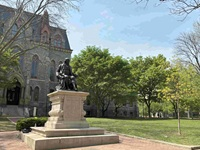Speaker
Description
The Beta-decay Paul Trap (BPT) at Argonne National Laboratory primarily studies the beta delayed-alpha decays of $^8$Li and $^8$B to measure the beta-neutrino angular correlation coefficient in these decays to search for a tensor contribution to the weak interaction. Additionally, the BPT is able to directly measure the $^8$B unoscillated neutrino spectrum, an important input for current and next generation solar neutrino detectors. The BPT uses four, 1 mm thick double-sided silicon strip detectors for 25% solid angle coverage with angular resolution of $\sim 2^{\circ}$, which sample the $\beta$ energy due to their thickness. One present experimental limitation is the lack of discrimination between $\alpha$ and $\beta$ particles below $\sim 1$ MeV, a portion of the energy spectrum which has a large impact on the reconstruction of the $^8$B neutrino spectrum. To overcome this limitation, we investigate using pulse shape discrimination to distinguish between $\alpha$ and $\beta$ particles in thick silicon detectors, with promising performance under both simple approaches and more complex machine learning techniques.

